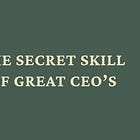Exhausted from treatment at the Chestnut Lodge psychiatric facility, Philip Graham had convinced the hospital doctors to allow him and his wife Katharine to stay at their rural farmhouse in Marshall, Virginia, for the weekend.
Whilst Philip and Katharine were both taking an afternoon nap, Philip got up and said that he wanted to go and lie down in another room. A few moments later, Katharine heard an ear-splitting bang. Scurrying to find where it came from, and upon opening the door, she found her husband Philip lying there after he had committed suicide by shotgun.
Katharine Graham is one of eight remarkable CEOs discussed in the legendary book on capital allocation—The Outsiders.
So, why have I chosen to open with such a personal and heartbreaking story?
Before his death, her husband Philip was CEO of The Washington Post Company, after her father Eugene Meyer, who was a major figure in American finance and public service, had chosen Philip over Katharine to succeed him in taking over the Post. In fact, Katharine was never even considered by her father, and similarly the thought of him choosing her never even crossed her mind—simply because women didn’t belong in boardrooms.
At the time of Philip’s suicide, Katharine Graham was 46 years old, a mother of 4, and without a regular job in over 20 years. She had zero business experience—let alone had she expressed any leadership qualities. Yet, she would go on to be one of the most successful CEOs of all time, generating a staggering 22.3% compound annual return. $1 invested in The Washington Post when it IPO’d under her stewardship in 1971 would have been worth $89 when she stepped down in 1993.
How did she do this when troves of CEOs with MBAs have sent companies into the abyss?
Today’s members-only post walks you through examples of how the CEOs in this book, often to the befuddlement of Wall Street, became some of the best capital allocators of all time. They pioneered new investor metrics, focused almost exclusively on deploying company cash, and knew the ins and outs of all options available to them at any given moment, so that when they did bet—they bet big, and with unwavering conviction. If you haven’t read the first essay where I introduce the 5 capital allocation strategies at a CEO’s disposal, you can read it here:
How to Eat The Investing “Playbook” for Breakfast
I change my mind when the facts change. What do you do?
— John Maynard Keynes



